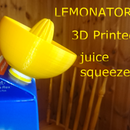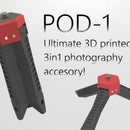Introduction: Coanda Effect - Experiment, 3D Printed Model, Explaination.
What bring me to write this instructable is pure accident.Few weeks ago, I was looking for tesla turbines over Youtube and found one little video that shows this effect. I got really interested. Just because I feel like sharing my knowledge, I am writing this information to you because like Albert Einstein said:
'The more I learn, the more I realize how much I don't know.'
So I thought that I can teach you something so you will more curious about world around you ;)
If you are teacher please pass this knowledge to your students maybe they will be interested. I have prepared a 3D model that will show Coanda effect that you can print and use in class to demonstrate it. If you don't have access to 3D printer there is also an experiment that will allow you to show Coanda effect using liquids.
In the next steps I will:
- explain how Coanda effect works and give you a little history lesson about it (videos included!)
- show you how you can perform Coanda effect experiment in your home
- make 3D model of turbine that you can print to perform Coanda experiment with air.
Step 1: So What Is Behind This "Coanda Magic"?
Coanda effect is basically the tendency of a fluid jet to be attracted to a nearby surface. But... What this exactly means? You may know, or you may not know, but you experience Coanda effect very often in daily life. It occurs when you wash dishes or car... sometimes even when you take shower! In one word it is everywhere! You may ask: "Is there any practical use of this effect?" and I will answer: "Yes".
Effect itself was discovered when Henri Coandă
was experimenting with his Coandă 1910 aircraft with unusual engine designed by him. In 1934 Coandă patented his discovery as "Method and apparatus for deviation of a fluid into another fluid". However it is not self-explanatory term and then effect was described as the "Deviation of a plain jet of a fluid that penetrates another fluid in the vicinity of a convex wall"
Description is not as interesting as the effect itself. It have a lot of very uncommon uses.
Using the Coanda effect John Carver from Avro Canada invented "inverted hovercraft" called Avrocar. In the regular hovercraft there is sort of "plastic bag" underneath the main body, but in Carver's invention there is... well.. nothing. It looks quite like UFO. You can read more about it here. And you can watch video here.
In todays life there is a lot of use of Coanda effect in various high-lift devices on aircraft where air moving over the wing can be "bent down" towards the ground using flaps and a jet sheet blowing over the curved surface of the top of the wing. It is used in air conditioning systems, meteorology, medicine and also in Formula One racing.
I found that it is used in UAV drones as well. The drone that is shown in this video is VTOL aircraft which stands for Vertical Take-Off and Landing.
To read more about coanda effect go to the Wikipedia page: HERE
Let's find out how we can experience Coanda effect by making an experiment!
Step 2: The Experiment That Every One Can Do!
"There is no spoon."
Well... maybe... but you have to get one. Preferably the single use one made out of polystyrene, or any other light spoon. Metal spoon will work, but the effect won't be really visible.
Now you have to go to the bathroom or kitchen. Take your children, wife, dog or hamster and show them Coanda magic!
You want a medium stream of water coming from your tap. Next grab the end of spoon and let it freely hang. With other hand pull the second end of the spoon towards the stream of water. You will notice that the spoon was "sucked" under the stream. And yes. This is Coanda Effect. Now you can move your fingers a little bit away from the stream of water but the "sucked" end will stay under the stream.
We can also notice that when we hold the spoon stiff with our fingers we can bend the stream of water and make it flow in the other direction. It is caused by the attraction of water to the spoon surface.
I am sure that you know the experiment when you turn on hairdryer and place a ping-pong ball in the stream of air. The ping-pong ball will float in the air even if the hairdryer is in angle. There is Coanda effect behind it also. The surface of ball is attracted by the down side of the stream and with combination of Magnus effect (another fun effect!) it prevents ping-pong ball from falling on the ground.
Step 3: 3D Printed Demonstration Model Design.
If you have 3D printer, you can perform the experiment by 3D printing the rotor attaching it to the motor and metal bowl. After printing you have to find out which direction it must turn to blow the air outside it. As you will notice the air is blown in the parallel direction to the rotor plane. The bowl have to be curved!
Now attach the rotor with motor to the bowl as you can see in the 3D model. If you made a little bigger model go outside and turn it on. Coanda effect occurs also here. Blown air is attracted by the surface of the bowl and changes direction downwards. This was used in the UAV drone mentioned before.
I realize that everyone will find its own bowl so before printing the rotor don't forget to scale it! So it is matching your bowl.
The effect is easily seen by adding smoke to make the air stream more visible. I highly recommend watching this video: HERE
Attachments
Step 4: That's All!
I hope that I get you interested in this small science experiment, let me know if you enjoyed it!
Remember to always explore your environment and be curious about how things works!
As always - you can follow me to be notified when I post another instructable. And if you make this experiment remember to post photos! Take your kids, and show them a little bit of science! Be sure to check out my other science projects for children!
Write in the comments where you experienced Coanda effect in your life!
Thank you for reanding!
(hey... it is my 20th instructable!!! wooohoooo!)





